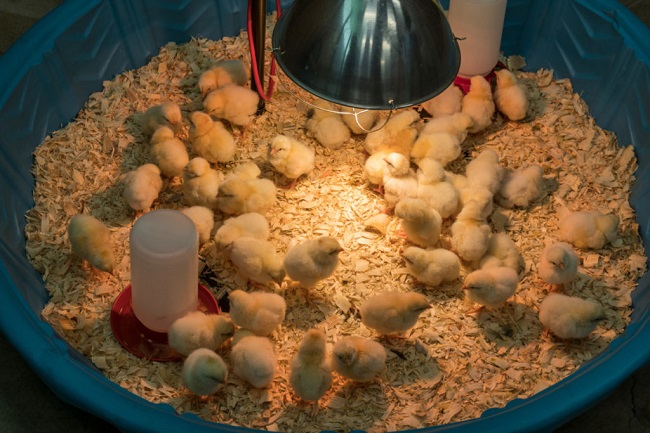
Getting chicks & pullets off to a fast start is important. Follow these steps to increase your success.
Infrared lamps provide a convenient heat source for brooding chicks. Use porcelain sockets approved for these lamps and suspend the lamps with a chain or wire (not the electric cord) so they are no closer than 15 inches to the litter. If the average brooder house temperature is 50 degrees F, one 250-watt infrared lamp is generally sufficient for heating 80 chicks. One chick can be added to this estimate for every degree over 50 degrees F. You should use more than one lamp so the chicks will not be without heat if a lamp burns out. Supply more heat by lowering the lamps to 15 inches above the litter or by using more or higher-wattage lamps. To reduce heat, turn off some lamps, use smaller lamps, or raise the lamps to 24 inches above the litter. You are heating the chicks only and not the air, so air temperature measurements cannot be used as a guide to chick comfort when using infrared lamps. Small brooders with an electric heating element can be purchased for brooding small numbers of chicks. Read this article for information on how a simple light bulb brooder can be made.
Most of the larger brooders use gas or oil as fuel to supply heat more adequately. When using a brooder, start the chicks at 90° to 95° F, measured 2 inches off the floor under the edge of the hover. Reduce the temperature by 5°per week until the supplemental heat is no longer needed. Observe the chicks to gauge their level of comfort. If they crowd together under the brooder, increase the heat, but lower the temperature if they tend to move away from the heat source. Allow 7 -10 square inches of space under the brooder for each chick. Start the brooder the day before the chicks arrive and adjust to proper operating temperature. Provide half a square foot of brooder house space per chick from 1 day to 6 weeks of age. Allow 1 ½ to 2 square feet of floor space for Leghorn pullets and 2 to 2 ½ square feet for heaving breed pullets confined during the growing period.
Place feed on chick box lids or trays from cut-down card-board boxes for the first few days. Feed and water should be available to the chicks as soon as they arrive. Provide 1 lineal inch of feeding space per chick at the hoppers at first and increase to about 2 inches after chicks are 2 weeks old. After 8 weeks, provide 3 to 4 inches of feeding space for growing pullets. A hanging tube-type feeder 15 inches in diameter will feed about 30 birds. Less feed is wasted by filling hoppers only half full and adjusting feeder height or size to bird size. Provide a one-gallon water fountain per 50 chicks during the first 2 weeks, Increase the number or size of waterers from 2 to 10 weeks to provide 40 inches of watering space per 100 birds or 1 gallon capacity per 10 birds if using fountains.
Roosts may be used with pullets after 6 weeks of age. Use poles of 2-inch lumber with top edges rounded and placed 12 to 15 inches apart. The roosting rack can be on a slant, from floor level to about 24 inches high at the rear, or it can be placed on a screened platform over a droppings pit. Allow 6 lineal inches of roosting space for pullets.
Related Articles & Free Email Newsletter Sign Up
How Chickens Have Played a Role in Religion and Mythology
The 4 Signs of Healthy Chickens




Comment here